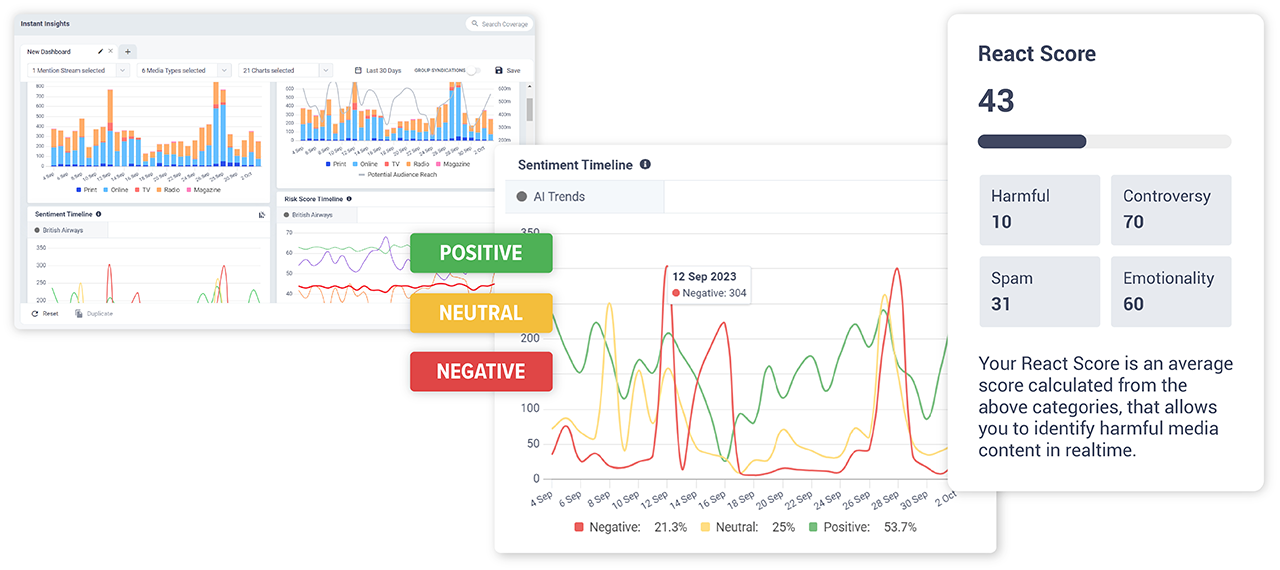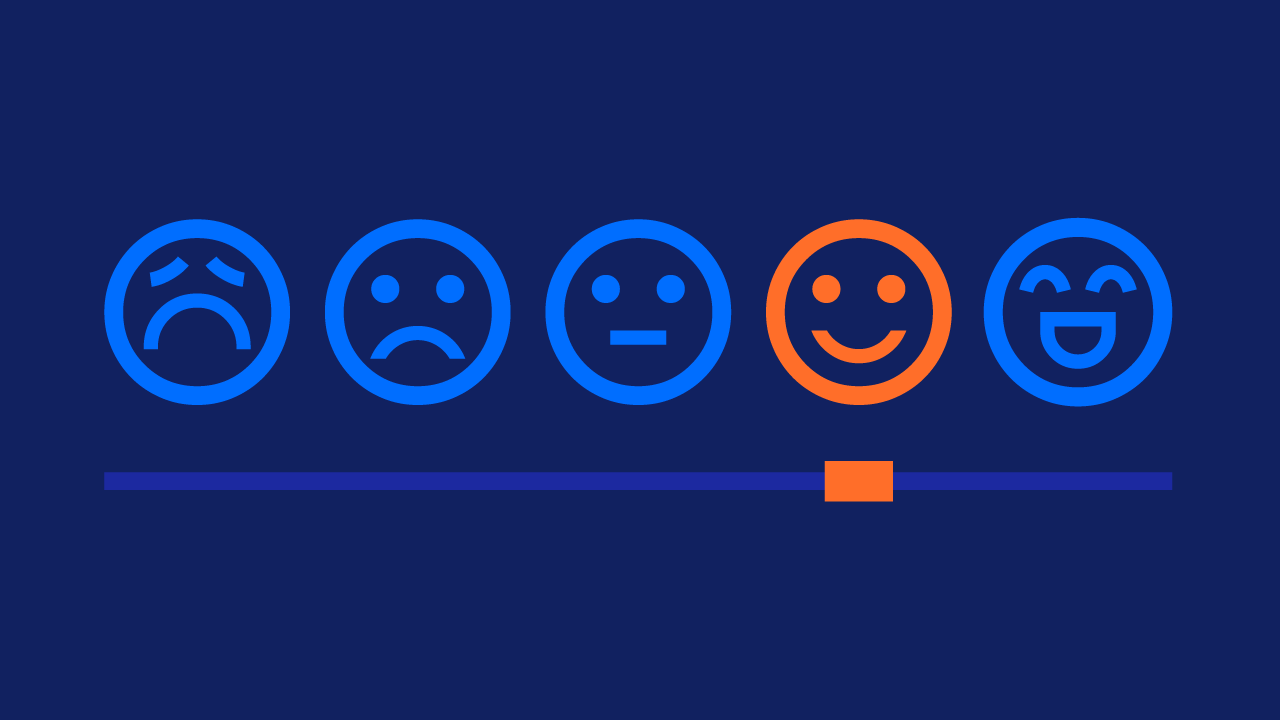Brand mentions are happening around the clock, online, in print, in broadcast, and across myriad social media platforms. If your brand is out in the world, there’s a very good chance it’s being talked about – and if you’re not aware of what’s being said, you’ll never know where you sit in the overall conversation. According to the 2024 Global Comms Report, just 22% of comms leaders rate their ability to track and analyze public sentiment as “excellent” – and only 25% rate themselves as “excellent” in their ability to understand drivers of brand reputation.
Measuring share of voice will give you an idea how much your brand if being discussed, but that alone won’t paint a full picture. You need to analyze the sentiment of your audience’s posts to understand the true feeling about your brand.
What is Brand Sentiment?
Brand sentiment refers to any mention of your brand in the media and the underlying feelings behind them. Within PR, sentiment analysis is a common tool to track this word-of-mouth brand awareness strategy over time. Powered by AI, sentiment analysis will look at the context and emphasis behind the opinions expressed then classify them as positive, negative, or neutral.
By gathering these opinions at scale, it can quickly give you a snapshot of how well you’re being perceived by customers or target audiences. Take the below example of Buzz Cola (name has been changed to anonymize the real brand behind this data) – you can see a 30-day timeline (sourced from CisionOne) showing the peaks and valleys of positive, negative, and neutral sentiment across coverage.

What Are the Benefits of Using Brand Sentiment?
There are various reasons why PR teams may want to measure brand sentiment. Most obviously, getting to know your own audience can help you evaluate your reputation in the market and tailor your PR strategy accordingly. It can also help you improve your customer experience if you know what people think about your product or service. What are their reasons for liking or disliking, and what can you do to either cement its position or improve it?
Using sentiment analysis over time can also measure changes in opinion and ensure you anticipate issues emerging from discussion around your brand. This can help you take quick action and address any problems before they become a crisis.
Let’s go back to our Buzz Cola example. The below timeline shows positive sentiment falling, negative rising, and the two briefly crossing over before again changing direction. Here our brand saw negative discussion trending upward (perhaps due to a recipe change or price rise) but this was quickly reversed (perhaps through strategic press outreach that resulted in positive media coverage) and saw positive sentiment begin to climb again.

Outside of your own brand sentiment, there’s also value in looking at how audiences talk about your competitors. Sentiment analysis will give you an idea on how competitor products are faring and their relative strengths and weaknesses. Spotting a rival brand experiencing negative brand sentiment may present an opportunity to launch a campaign to strengthen your own position in the market.
Tools and Resources for Measuring Brand Sentiment
There are plenty of methods to help you track brand sentiment across different sources, giving valuable insight to inform your PR and comms strategies and how you interact with customers.
- Media monitoring: Tools like CisionOne can monitor print, online, broadcast, and social platforms for mentions of your brand or products. Plus, you can set up keyword searches for related terms that might be relevant. Many of these monitoring tools include useful features – think word clouds of grouped themes, share of voice charts, and geographical breakdowns – allowing you to draw out deeper insights into sentiment analysis.
- Social monitoring and listening: If your brand if primarily focused on social conversations and extracting meaning from this data then a platform like Brandwatch can serve as an all-in-one suite to cover these channels.
- Online forums and review sites: Customer review sites like Yelp and Trustpilot are excellent resources for seeing brand sentiment. Depending on your business, or product, both Google and Amazon reviews will offer customer feedback and the chance to respond, plus an overall star rating to gauge opinion.
- Online surveys: If you have a database of customers you’re able to call on, or an engaged social following, then conducting a survey can provide valuable feedback on brand sentiment. There’s value in continually running these to see how sentiment and feeling evolves over time. Platforms like SurveyMonkey and Google Forms offer ways to collect and sort this data.
- Focus groups: These give you an opportunity to get direct feedback from a smaller, more targeted group of customers (or potential customers). While monitoring and surveys lean to quantitative data, discussion groups can dig into more qualitative reasons behind perceptions and feelings toward your brand or product.
- Net Promotor Score (NPS): This customer loyalty and satisfaction measurement comes from asking customers how likely they are to recommend a product or service to others on a scale of 0 to 10. NPS scores give brands a benchmark to increase their score and improve brand sentiment over time by winning over customers.
5 Steps for Measuring Brand Sentiment Effectively
Once you have the tools and resources in place to measure brand sentiment, it’s critical to set out a clear strategy to get the most out of them. Taking the five-step approach below will give you guidelines and structure for tracking and improving how your brand is perceived.
1. Use Sentiment Analysis Tools
Media and social monitoring platforms like CisionOne are a good place to start here. They can be set up to track brand mentions over time, and most will include in-built sentiment analysis tools for you to gauge opinion. CisionOne even includes advanced options like React Score (see below), which digs deeper into the sentiment to detect specific factors around earned media mentions.

2. Set Realistic Goals
Setting a goal of 100% positive sentiment from the start would be unrealistic and impossible to achieve. The majority of your mentions will have neutral sentiment, so your goal should always be to increase the positive. Start small and aim to build up by small, singular percentages.
3. Benchmark for Success
Take a stretch of time and use the sentiment measured as your baseline. Going forward, you can compare your sentiment against that benchmark to judge your success. Another option is to set specific, time-based benchmarks and compare your progress week-on-week, month-on-month, or year-on-year.
4. Look for Opportunities
Analyze your results regularly, and look for the meaning behind them. Where are you seeing areas for improvement? Use the data you gather to take action. Negative and neutral sentiment can be turned positive with work. Engage with customer complaints, and be on the lookout for crises (are your brand mentions spiking?). Sentiment analysis will not only help you identify a potential crisis faster, but it will help you “read the room” to understand what action to take next, and ultimately give you a better chance of mitigating any issues before they become a full-on crisis.
5. Refine Your Strategy
Once you’ve established your measurement strategy and start seeing results, your work isn’t finished. Now it’s time to re-assess and refine your approach to brand sentiment. After you see the initial results come in, you will likely find it necessary to adjust your goals, perhaps reaching for higher percentages of neutral or positive sentiments, and re-evaluate any planned or current PR campaigns. Feed these steps into your overall PR and comms approach to keep improving your brand sentiment.
Keep in mind: Improving brand sentiment won’t happen overnight. It takes consistent and continual time and effort, and may even involve some experimentation. But the more you invest in it, the more you will see improvements over time.
Ready to start measuring brand sentiment? Find out how CisionOne can help you analyze your earned media. Explore the platform or make time to speak with one of our experts.








